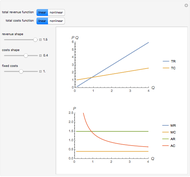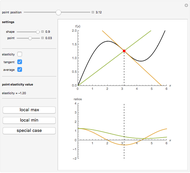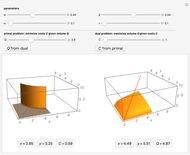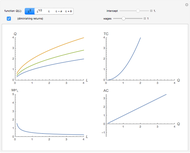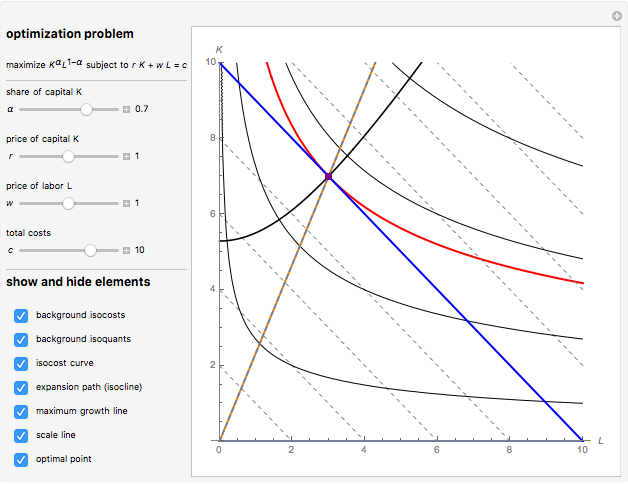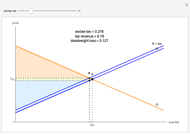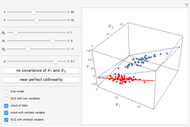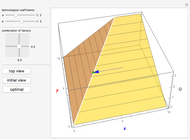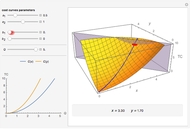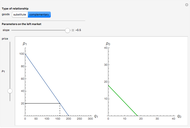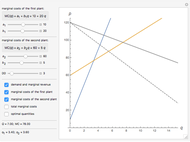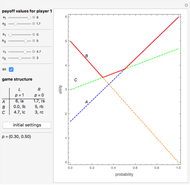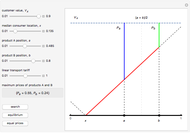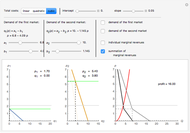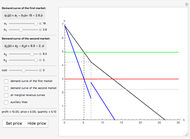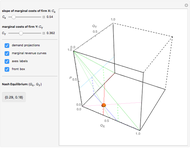Supply Curve from Piecewise Linear Cost Function

Requires a Wolfram Notebook System
Interact on desktop, mobile and cloud with the free Wolfram Player or other Wolfram Language products.
This Demonstration shows how to define a supply curve if a marginal cost curve is piecewise and "broken." The problem of the price-taking competitive firm is to define which quantity to produce if the price is set in the range between two edge points, or, to put it differently, which piece of the cost curve to use to define the quantity  given the price,
given the price,  , where
, where  is given. For simplicity, we consider linear cost functions (and that the average cost curve intersects the marginal cost curve at the origin). We show the principal approach to the problem, which can be generalized to arbitrary cost functions with many break points.
is given. For simplicity, we consider linear cost functions (and that the average cost curve intersects the marginal cost curve at the origin). We show the principal approach to the problem, which can be generalized to arbitrary cost functions with many break points.
Contributed by: Timur Gareev (October 2015)
Immanuel Kant Baltic Federal University
Open content licensed under CC BY-NC-SA
Details
Suppose we know that a firm has a piecewise cost function of the following form:  if
if  and
and  if
if  , where
, where  and where
and where  is constant and stands for a given quantity where the cost curve breaks between the
is constant and stands for a given quantity where the cost curve breaks between the  and
and  pieces (we may change it with the respective control). This outset differs from the usual case with
pieces (we may change it with the respective control). This outset differs from the usual case with  in the following point: the firm should define what quantity
in the following point: the firm should define what quantity  to produce if the market price is in the range
to produce if the market price is in the range  (i.e. it has two options: to use
(i.e. it has two options: to use  or
or  pieces). In more general terms, the firm should define its supply curve, which does not simply coincide with the cost curve in this case. Note that if the firm produces according to the first piece of the cost curve,
pieces). In more general terms, the firm should define its supply curve, which does not simply coincide with the cost curve in this case. Note that if the firm produces according to the first piece of the cost curve,  , there is nothing special to analyze. But if the firm switches to the
, there is nothing special to analyze. But if the firm switches to the  piece of the cost curve, then there is a challenge: is it profitable or not? Indeed, to move to the
piece of the cost curve, then there is a challenge: is it profitable or not? Indeed, to move to the  piece, given the price, there are first some losses before the "breaking" quantity
piece, given the price, there are first some losses before the "breaking" quantity  level of production, and then some profits. (See this by changing the
level of production, and then some profits. (See this by changing the  slider and observing the red and green triangles.) The trick is to integrate those triangles to define the break-even price level
slider and observing the red and green triangles.) The trick is to integrate those triangles to define the break-even price level  , where the producer is indifferent between two pieces of the cost curve. This price
, where the producer is indifferent between two pieces of the cost curve. This price  is found by solving the following equation:
is found by solving the following equation:
 .
.
This price level allows us to define the horizontal "break" level of the supply curve (can be shown by the checkbox on the graph). This also means that the red and green triangles on the graph have equal areas. In economic terms, red corresponds to losses and green reflects profits. When profits and losses are equal, the producer is indifferent between the two alternatives, so the supply curve (derived from the marginal cost curve lying above the average cost curve) has a discontinuity between the two indifferent solutions. In this "problematic" range of prices  , one cannot switch to the
, one cannot switch to the  piece of the cost curve without suffering some losses that should be compensated by additional profits. (You can see the supply curve on the graph by checking the checkbox of the respective control.) As a result, we may define the supply curve that becomes discontinuous in this model.
piece of the cost curve without suffering some losses that should be compensated by additional profits. (You can see the supply curve on the graph by checking the checkbox of the respective control.) As a result, we may define the supply curve that becomes discontinuous in this model.
Snapshots
Permanent Citation







